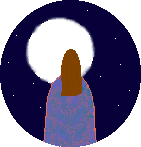
After Rob sent me the first part of Neftoon Zamora, I found myself so intrigued with the story, that I myself set out for the New Mexican desert in search of the elusive Neftoon. Sadly, I did not find much, save the beautiful starry skies Nez mentions and this, which I found stuck inside the bleached skull of a long-dead long horn.
The Teet ( I ) Chings of Dogie Hoofprint
What is a cow?
Most of us look out from our car windows, as we travel the backroads of rural America and see only a furry, four footed creature chewing contentedly on a lump of regurgitated clover and alfalfa. If we are not in a hurry, we may slow down or stop the car altogether and roll the window down for a better look.
Either way, as we watch that seemingly gentle creature lift her soft brown eyes our way and flick her ear at an annoying fly, few of us will resist the urge to "moo" at her before hurtling once again toward our all important destinations.
We will not linger long enough to see beyond her calm exterior to the inner turmoil. It would not matter much if we did, for the cow is uniquely skilled in regurgitating her vile smelling anger and pain, only to swallow it down again as inner peace. And you should be glad that she is, for it is this skill alone which prevents her from charging your car as you mock her, killing your entire family in a blind fury of horns and hooves.
The cow is a pathetic tortured creature from the day it is born. Cast in the sad lot of livestock captivity, she never tastes the sweet grass on freedom's side of the fence. Any attempt to nibble the tender blades which poke through the wires is greeted with a terrific jolt which is at once terrifying and stupefying. And there are days when she considers throwing herself upon the fence, but she swallows that down, too.
The cow is never allowed even to run among the buttercups and dandelions of her own prison yard. To do so, would only make her meat stringy and tough.
The cow must stand still as day after day she endures the humilation of having her teets fondled and yanked by the cold hands of her captor. And while that captor, known to us as "the farmer" is also the one who cares for her, bringing fresh hay for her manger, cracking the ice from her water in winter and cleaning the floor of the stall which serves as her cell, he is still her captor and will have her killed when she is no longer of use to him.
If she is not healthy, death will come in the form of a shot--from a needle or a gun, it makes little difference-- and her carcass will be tossed atop a few dozen others to travel through your sleepy towns and villages under cover of night on its way to the Rendering Works.
If she is strong and healthy, she will climb into a truck too crowded to hold her with a full breath in her lungs. As she stumbles out of the truck at the end of the journey and breathes in the stench of slaughter house death, she will appear calm and dazed for she accepts and welcomes her own death.
But, as she is being led along the final steps of her life's path, she will think back to the pasture and the hot sun warming her back on a lazy summer afternoon. She will think of your "moo" as you passed her and for the first time, see the humor in it. For a moment, she will long for life. All of the joy and pain and love and hatred she thought she'd chewed the flavor out of will come surging forth from the bellows of her stomachs, gurgling up in her throat, choking her as she tries to pull away. Then, the sledgehammer will fall with a sickening thud between the long silky eyelashes she once batted at you as you "moo"ed to her that day so long ago.
After this, the cow transcends its bovine existence, to become many things: hamburgers, handbags, fine suede boots... The list goes on, even if she does not.
When next you find yourself on the backroads of rural America, stop again at her empty pasture. Roll down your window and breathe for a moment. Let your eyes dance over the meadow as her hooves never could. Maybe, if you're not too rushed, you'll notice that, in her absence, the grass grows tallest where she deposited her dreams.
BACK to Melhican Texts
OR back to Table of Contents
E-Mel